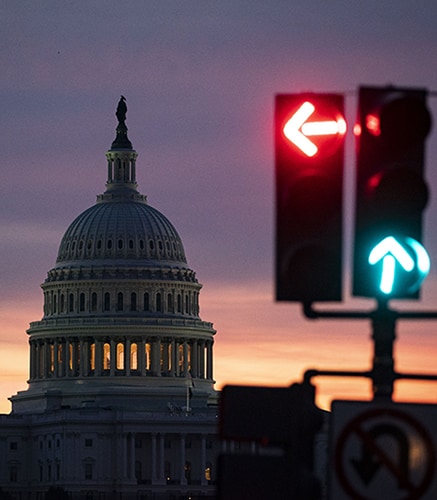
Jane G. Ditelberg
Director of Tax Planning, The Northern Trust Institute
July 19, 2024
One of the major tax issues at stake in the November election is the fate of the provisions of the Tax Cuts and Jobs Act (TCJA) of 2017 that are scheduled to sunset at the end of 2025. Absent action by Congress, these provisions will expire and revert to the law in effect before the enactment of the TCJA. It is not clear whether the sunset will occur, but it will take Republican control of the House and the Senate and either a veto-proof majority or a Republican president to pass legislation to extend the TCJA provisions.
Many commentators have focused on the estate and gift tax consequences of a potential 2025 sunset, but there are also individual income tax provisions subject to the same sunset provisions. The standard deduction, the personal exemption, the cap on deductions for state and local taxes (SALT) and the alternative minimum tax (AMT) would all be impacted, as would the tax rates themselves. In the absence of new legislation, the following are some of the key individual income tax provisions that will sunset on December 31, 2025.
Individual Income Tax Rates
The TCJA reduced the top marginal individual income tax rate and most of the rates for lower brackets. A sunset will return these rates to pre-TCJA levels. As demonstrated in the table below, this will not only increase the rate for those in the top bracket; only those who are in the lowest tax bracket of 10% will be unaffected—All other taxpayers will have at least part of their income taxed at higher rates. In addition, the highest bracket of 39.6% is reached at a lower income threshold. The exact bracket ranges will depend on the inflation adjustments.
| Current Individual Income Tax Rates | Post Sunset Individual Income Tax Rates |
|---|---|
| 10% | 10% |
| 12% | 15% |
| 22% | 25% |
| 24% | 28% |
| 32% | 33% |
| 35% | 35% |
| 37% | 39.6% |
The Net Investment Income Tax will not be impacted by the sunset. The tax rates for qualified dividends and long-term capital gains also will not change, but the TCJA’s shift in how the brackets were constructed, which benefits higher income taxpayers, will sunset.
The Personal Exemption, Dependent Exemption and Child Tax Credit
The TCJA eliminated the personal exemption for the taxpayer and the taxpayer’s spouse, as well as the exemption for dependents. It doubled the child tax credit to $2,000 for children 17 and under, made it available to more taxpayers and increased the amount that can be refunded. It also created a new $500 dependent credit for those not eligible for dependent child status, such as college students and other adult family members qualifying as dependents. These provisions will sunset if no action is taken.
The personal exemption will be back; because it is increased for inflation it is expected to return at close to $5,000 in 2026. This exemption will provide the greatest benefit to bigger families, particularly those with older dependents. The credit for non-child dependents will also expire and the child tax credit will return to pre-TCJA levels.
Example:
Lee and Campbell are married and have four children who in 2024 are aged 10, 12, 17 and 20. Lee’s half-sister, aged 25, lives with them, and they provide more than 50% of her support. They are in the 35% marginal income tax bracket. Let’s compare the credits and exemptions available for their family this year with those available in 2026 after the sunset:
| 2024 | 2024 tax benefit | 2026 | 2026 tax benefit | |
|---|---|---|---|---|
| Personal Exemption | 0 | $0 | $10,000 | $3,500 |
| Dependent Exemptions | 0 | $0 | $25,000 | $8,750 |
| Child Tax Credit | $4,000 | $4,000 | $2,000 | $2,000 |
| Other Dependent Credit | $1,500 | $1,500 | $0 | $0 |
| Total | $5,500 | $14,250 |
The child tax credit phases out at income above $400,000 for married couples filing jointly in 2024. In 2026, it will phase out at income above $110,000, which means that Lee and Campbell may not be able to get the full (or any) benefit after the sunset.
Standard Deduction and Itemized Deductions:
The TCJA doubled the standard deduction and then eliminated other deductions that many taxpayers previously were able to take. The increased standard deduction benefitted those who did not have as many itemized deductions, but the elimination or cap on other deductions may have increased taxes for taxpayers who itemize. The following will be impacted by the sunset:
- Standard Deduction. The standard deduction for individual taxpayers under 65 is expected to drop from $14,600 to $8,300, and for married taxpayers under 65 filing jointly from $29,200 to $16,600.
- SALT Deduction. The TCJA limited deductions for state and local taxes to $10,000. This cap will be lifted by the sunset, which will benefit taxpayers in states with higher income tax rates or property tax bills. However, once again itemized deductions will phase out for higher-income taxpayers. In addition, increased SALT deductions will expose more taxpayers to the AMT.
- Mortgage Loan Interest Deduction. The TCJA eliminated the deduction for interest on a home equity loan and limited the deduction for interest to purchase-money mortgages of $750,000 or less. After the sunset, interest on home equity loans of up to $100,000 and on purchase-money mortgages of up to $1,000,000 will be deductible.
- Charitable Deductions. Currently, cash gifts to public charities are deductible up to 60% of the taxpayer’s Adjusted Gross Income (AGI). After the sunset, that limit is reduced to 50% of AGI.
- Casualty Losses. Under the TCJA, casualty losses are only deductible if there is a federal disaster declaration covering the event. This requirement will be eliminated upon the sunset and casualty losses not related to a federal disaster declaration will be deductible again.
- Miscellaneous Itemized Deductions. Miscellaneous itemized deductions were disallowed under the TCJA. These include things like investment advisory fees, legal fees and out-of-pocket employee expenses. After the sunset, these items will again be deductible to the extent they exceed 2% of the taxpayer’s AGI.
- Pease limitation on itemized deductions. The Pease limitation, which phased out the benefit of itemized deductions for higher income taxpayers, will return after the sunset.
Alternative Minimum Tax
The TCJA increased the threshold for the application of the AMT and increased the income threshold for phasing out personal exemptions. These will drop after the sunset. In addition, some deductions, including the one for SALT, which were disallowed under the TCJA, are preference items for AMT purposes. This means that increasing the availability of these deductions will also increase the number of taxpayers subject to the AMT, which blunts the benefit of the increased deductions.
Planning for a Possible Sunset
In planning for the possibility of a sunset, taxpayers will want to look at whether items of income and deduction can be shifted from one tax year to another. Consider the following:
- Roth IRA conversions may be more tax-effective prior to the sunset. This involves paying tax on assets currently in traditional IRA accounts and converting to Roth IRAs where the assets and the growth on them can be withdrawn tax-free after five years. In light of anticipated higher tax rates after the sunset, consider doing the Roth conversion prior to January 1, 2026.
- Taxpayers who can accelerate or defer ordinary income such as compensation may want to accelerate it into a pre-sunset tax year to take advantage of lower tax rates.
- Taxpayers who can defer expenses that constitute miscellaneous itemized deductions may want to defer them until after a sunset when they will be deductible.
- Taxpayers considering large gifts of cash to public charities may want to make them while the 60% limit on deductibility is in effect.
- Taxpayers considering a move to a higher state tax jurisdiction may want to defer until after the sunset when the higher taxes will not be subject to the SALT cap on deductions.
- Higher-income taxpayers should consult their tax preparers to review how the phase outs of credits and deductions will impact them, and whether the AMT will eliminate the benefits of some deductions.
The bottom line
The sunset of the TCJA is baked into the original legislation and will take effect on December 31, 2025, unless new tax legislation is enacted. The Republicans are primarily proposing to make the 2017 cuts permanent. The Democrats are proposing to allow many of the provisions to sunset, keep others and make other tax law changes. While we wait to see the outcome of the election and the legislative process, it is prudent for taxpayers to consult their tax preparers to determine the impact a sunset would have on their tax returns. It is not too early to start planning.



